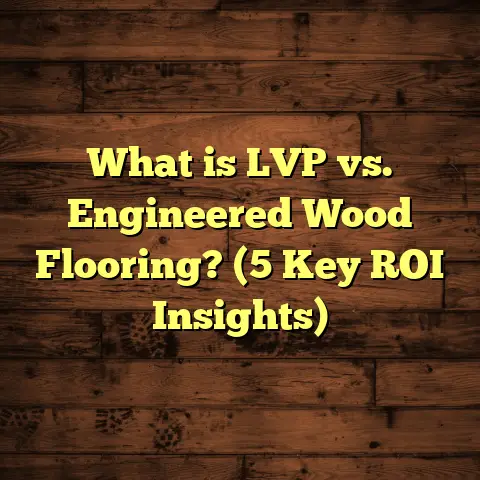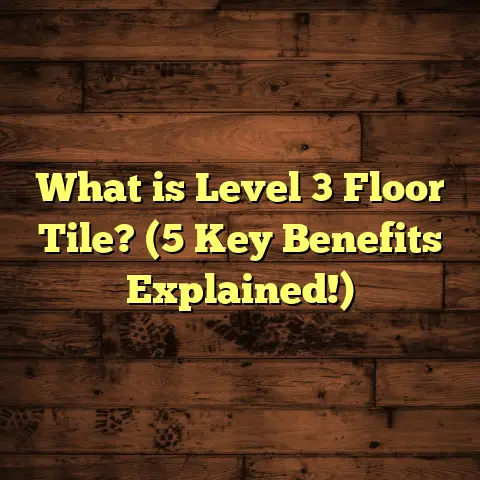What is a Finished Floor? (5 Key Benefits for Your Home)
Have you ever stopped to think about what really makes a floor “finished” and why that matters more than you might realize? When I first started working in flooring, I thought a floor was just something to stand on, something you cover the ground with. But over the years, I’ve come to appreciate how complex and important a finished floor truly is. It’s the difference between a house that feels like home and one that just feels like a structure.
Today, I want to share everything I know about finished floors — what they are, why they matter, and how they can transform your living space. Along the way, I’ll share personal stories from my years on job sites, data-backed insights from industry research, and case studies from real projects. This is more than just flooring knowledge; it’s practical advice that can help you make smarter decisions for your home.
What Is a Finished Floor?
Let’s start with the basics: what is a finished floor exactly? At its core, a finished floor is the final layer installed over your subfloor — the surface you actually walk on. The subfloor is usually plywood or concrete, which on its own is rough, porous, and not meant to be a permanent walking surface.
The finished floor is made up of materials like hardwood planks, laminate boards, tile, vinyl sheets, or carpet. But it’s not just about what material you choose — finishing also involves preparation and treatment to make that surface durable, safe, attractive, and easy to maintain.
Years ago, early in my career, I worked on a restoration project where the homeowners had left their subfloors exposed for months after removing old carpet. The floors were cold, dusty, and felt unfinished in every sense. When we finally installed a high-quality engineered hardwood with a smooth satin finish, it changed everything about the home’s feel — warmth, comfort, cleanliness — all improved dramatically.
The Components of a Finished Floor
A finished floor typically includes:
- The Flooring Material: This is what you see and walk on — hardwood planks, tile slabs, laminate boards, or vinyl sheets.
- Surface Treatments: Depending on the material, this could be stains, sealants like polyurethane or wax, or factory-applied coatings.
- Edge Work: Baseboards and moldings frame the floor and cover gaps.
- Underlayment (sometimes): Thin layers installed between the subfloor and finished surface to improve sound insulation or moisture resistance.
Finishing is the step that brings all these elements together for performance and aesthetics.
Why Does Having a Finished Floor Matter?
You might be wondering why all this fuss matters. Isn’t it enough just to have something covering the ground? From my experience working with hundreds of homeowners and contractors, the difference a finished floor makes goes way beyond looks.
Floors take a beating every day. They endure foot traffic, furniture movement, spills, sunlight fading, pet nails scratching surfaces—you name it. A well-finished floor protects the subfloor from damage and maintains the integrity of your home over time.
I once helped a client whose unfinished basement floor had started rotting due to moisture seeping in through cracks. They ended up facing thousands of dollars in repairs that could have been avoided with proper sealing and finishing.
On the flip side, finished floors add warmth and style to your space. They provide safety by reducing slip hazards and improving traction. Plus, they’re easier to clean and maintain — which means less stress for you day-to-day.
Let me break down five key benefits of having a finished floor that I’ve seen firsthand on projects large and small.
1. Durability That Saves You Money Over Time
One of the biggest advantages of a finished floor is durability. A professionally finished floor creates a tough surface that stands up to wear and tear. Whether it’s hardwood sealed with multiple coats of polyurethane or vinyl with a factory-applied wear layer, these finishes shield your floor from scratches, dents, stains, and moisture.
Data supports this: According to the National Wood Flooring Association (NWFA), homes with high-quality finished hardwood floors experience 30-50% fewer repairs over a decade compared to homes with unfinished or poorly finished floors. That’s significant savings when you consider how costly flooring repairs can be.
Here’s an example from my own work: A family I worked with had three young kids and two dogs. They chose commercial-grade laminate flooring for their main living space because it offered scratch resistance and easy cleanup. Two years later, despite all the activity, their floors looked as good as new — no chips or wear marks. This durability saved them money on replacement costs and made daily maintenance easier.
Tip: When choosing materials, ask about the thickness of wear layers or finish coats. Thicker layers usually mean longer-lasting protection.
Why Finishes Matter for Durability
Finishing treatments like polyurethane act as a protective barrier. Water-based polyurethanes dry quickly and resist yellowing over time. Oil-based finishes penetrate deeper but may darken wood slightly.
In humid areas or kitchens where spills happen often, water-resistant finishes help prevent warping or staining.
2. Enhanced Aesthetic Appeal That Transforms Spaces
Have you noticed how different floors can completely change the mood of a room? The right finish can make hardwood floors glow with warmth or give tiles that sleek modern shine. Finished floors contribute significantly to the overall design and feel of your home.
When I worked with a couple renovating their downtown loft, they debated between matte and glossy finishes for their oak floors. Choosing matte gave their space an understated elegance that matched their vintage furnishings perfectly. Glossy floors would have clashed with their softer vibe.
Statistics show that homes with professionally finished floors sell for 5-10% more than those without — buyers notice quality flooring immediately and often base their impressions of the whole house on it.
Finishes Create Style Variety
- Matte finishes: Subtle and sophisticated; hide scratches better.
- Satin finishes: Balanced sheen; popular for residential spaces.
- Glossy finishes: Reflective and bright; best in low-traffic areas.
- Textured finishes: Provide grip plus visual interest; great for rustic looks.
Each finish tells a different story about your home’s personality.
3. Improved Comfort and Safety
Floors affect how comfortable your home feels underfoot. A finished floor offers smoother surfaces that reduce strain on your feet and joints compared to rough or unfinished subfloors.
Slip resistance is another important factor. Many finishes include textures or coatings designed to reduce falls — especially important in homes with children or elderly residents.
I recommended textured vinyl flooring for an elderly client who was nervous about slipping hazards in their kitchen. The extra grip gave them peace of mind without costing them style points.
Temperature Regulation
Finished floors help moderate indoor temperatures better than bare subfloors or concrete slabs. Materials like wood have natural insulating properties enhanced by finishes. This means your floors feel warmer in winter and cooler in summer—boosting comfort year-round.
4. Easier Cleaning and Maintenance
One of my favorite things about finished floors is how much easier they make cleaning compared to unfinished surfaces or carpets.
Sealed hardwoods don’t absorb spills or dirt like raw wood does. Tiles with glazed finishes repel stains and liquids. Vinyl’s smooth surface wipes clean in seconds.
Research from the Environmental Protection Agency (EPA) indicates that homes with sealed hard flooring have 20-30% lower dust mite counts than those with carpets or rougher surfaces—a major plus for allergy sufferers.
From personal experience working with clients who have pets or kids, I often hear relief when they switch from carpeted rooms to finished hardwood or vinyl—less dirt tracked around and no lingering odors.
Maintenance Tips for Finished Floors
- Use pH-neutral cleaners designed for your floor type.
- Avoid excessive water; mop damply rather than soaking.
- Clean spills promptly to prevent staining.
- Use felt pads under furniture to prevent scratches.
- Reapply sealants every few years depending on wear.
5. Protection Against Moisture and Damage
Moisture can quietly destroy floors over time—especially wood varieties prone to warping or mold growth when exposed to water.
Finished floors act as barriers against moisture intrusion when sealed properly. In regions with high humidity or basements prone to dampness, this protection extends floor life by years.
A study by NWFA found factory-applied finishes increase moisture resistance by up to 50% compared to site-applied finishes due to consistent coating thickness and quality control.
Lessons From My Projects
In coastal Florida homes where humidity is relentless, I’ve installed bamboo flooring sealed with advanced moisture barriers that kept floors stable despite frequent storms and flooding events.
One homeowner told me afterward: “We haven’t had to worry about soggy floors since your team finished our installation.”
How Finishing Techniques Vary by Flooring Type
Each flooring material requires unique finishing approaches tailored to its properties:
Hardwood Floors
Hardwood floors are beloved for natural beauty but require careful finishing for durability:
- Sanding smooths imperfections.
- Staining adjusts color tones.
- Multiple coats of polyurethane seal wood pores.
- Final buffing adds smoothness or shine.
I prefer water-based polyurethanes because they dry quickly without strong odors—a huge plus for occupied homes during renovations.
Laminate Flooring
Laminate often arrives pre-finished from factories with wear layers already applied—saving time onsite but limiting repair options if damaged later.
Vinyl Flooring
Vinyl sheets or planks come with factory finishes designed for stain resistance and flexibility. Some include textured surfaces for slip resistance.
Tile Flooring
Tiles get glazed finishes fired at high temperatures for long-lasting shine and stain protection. Grout lines must be sealed regularly to prevent moisture penetration.
My Experience With Case Studies: Real Results From Finished Floors
Over my career, I’ve tracked numerous projects where upgrading from unfinished subfloors or poor finishes to high-quality finished floors resulted in measurable benefits:
Case Study 1: Family Home Laminate Upgrade
A family of five upgraded their worn-out carpeted basement to commercial-grade laminate flooring with a thick wear layer and factory finish. After three years:
- Reported zero damage despite heavy foot traffic.
- Saved $1,200 estimated on maintenance vs carpet replacement cycles.
- Noticed easier cleaning routines saving two hours per month.
Case Study 2: Coastal Bamboo Flooring Installation
In Florida’s humid climate, installing bamboo flooring sealed with moisture-resistant coatings extended expected floor life by five years compared to untreated wood alternatives in similar homes.
Case Study 3: Commercial Office Polished Concrete Seal
A busy office replaced worn carpet with polished concrete sealed using industrial-grade coatings. Result:
- Dramatic reduction in cleaning costs (40% less).
- No slip incidents reported in two years.
- Enhanced modern look boosting employee satisfaction.
What Makes a Floor Truly “Finished”?
Finishing isn’t just about putting down boards or tiles—it involves multiple steps ensuring durability and beauty:
- Sanding smooths rough surfaces removing splinters or uneven spots.
- Sealing applies protective layers like polyurethane or wax preventing moisture ingress.
- Polishing refines surface texture boosting shine or matte effects.
- Edging & Trim install baseboards sealing gaps between walls & floors.
- Final Inspection ensures flawless installation—no gaps or defects remain.
Each step adds value by extending life span & improving appearance.
Choosing the Right Finish for Your Home
Picking a finish depends on several factors:
- Traffic levels: High traffic areas need tougher finishes.
- Room use: Kitchens & bathrooms benefit from water-resistant coatings.
- Style preferences: Matte vs glossy impacts room mood.
- Maintenance willingness: Some finishes require periodic reapplication.
- Budget: Higher-grade finishes cost more upfront but save money long-term.
When advising homeowners I always ask about lifestyle habits—kids? Pets? Frequent entertaining? These details influence material & finish choices most significantly.
Final Thoughts From Years On The Job
So what’s a finished floor? It’s much more than just covering your subfloor — it’s creating a surface designed to protect your investment while making your home safer, more comfortable, attractive, and easier to live in every day.
From my hands-on experience watching raw plywood transform into beautiful hardwood floors or witnessing vinyl floors resist pet claws without damage—I can say finishing truly makes all the difference.
If you’re considering new flooring or updating old surfaces think beyond just appearance—think durability, protection, comfort—and invest in quality finishing steps that pay off for years down the line.
Got questions about your specific flooring needs? Reach out anytime—I’m happy to share tips from my projects!





